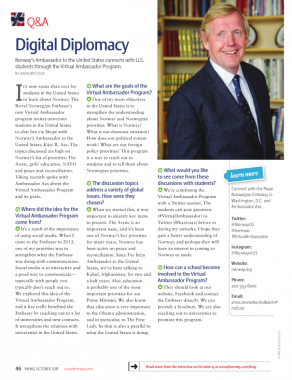
In the October issue of Viking magazine, the Ambassador discusses about The Virtual Ambassador program and Norway’s priorities. Check it out on page 46 and see more from the interview here.
Q: How would you describe Norway’s current role in NATO, and what role do you think it will play in ensuring the alliance’s effectiveness in the future?
A: What Norway brings to NATO is a lot of knowledge and understanding about the Arctic. We are one of the NATO countries boarding Russia. We’ve been living in peace with Russia for 1,000 years. Norway has been actively participating in international operations being conducted by NATO and the United Nations. We are a global actor, so I think we have a lot of experience and knowledge about what’s going on around the world.
Q: Why is it essential for young people in North America to be informed about issues facing Norway, and how can they take action to promote diplomacy?
A: I think it’s important for anyone to be engaged in what’s going on internationally. Norway can be contributing to that, and that’s the reason for doing it. Also, the Virtual Ambassador Program is very cost effective. I can turn on the television and interact with students.
Q: What do you see for the future of digital diplomacy?
A: It will become more and more important. Twitter is a key information tool. I go to Twitter and can look up articles from news agencies and individuals. What will improve in the future is the interactive part of it. We’re not just providing information, but we’re engaging with followers.
Q: What is it important for American students to study in Norway?
A: When students come to Norway, they get a look at an international society. They will get an idea of what the Nordic countries are doing. Plus, you’re going to an Arctic country. Ten percent of Norway’s population is north of the Arctic Circle, and one-third of Norwegian land territory is north of the Arctic Circle. I think any student should go somewhere, not just to Norway. Part of their education should be in another country. Or they can come intern with the Norwegian Embassy!
